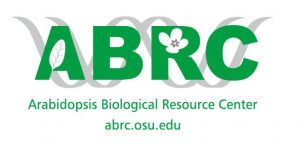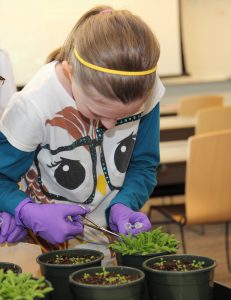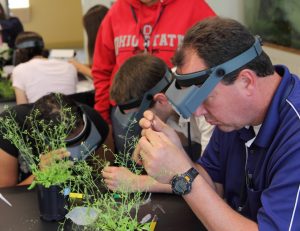By Courtney Price, Education & Outreach Specialist, Arabidopsis Biological Resource Center & Center for Applied Plant Sciences
In order to engage students in the learning process it is important to provide opportunities for hands-on activities that bring to life important science concepts. However, for some educators the task of developing new lesson plans that demonstrate advanced science concepts, such as genetics, can be daunting. Connecting science learning to real-world problems and current research initiatives can further complicate the process for teachers exploring topics outside of their area of expertise. Thankfully, there are a number of resources available to support educators through the curriculum development process.
Arabidopsis thaliana, a common weed that can be found in different environments around the world, was the first plant to have its genome completely sequenced. This fast growing plant serves as the model system for plant research. The Arabidopsis Biological Resource Center (ABRC- https://abrc.osu.edu/), which operates within the Center for Applied Plant Sciences (http://caps.osu.edu/) at The Ohio State University, is one of two global stock centers for Arabidopsis resources. ABRC, which maintains close to a million different stocks of Arabidopsis including seeds, DNA, antibodies and other resources, ships over 100,000 samples to researchers worldwide annually.
In addition to providing seeds and DNA resources for researchers, ABRC is committed to supporting K-12 and college level science education by providing teachers with the resources necessary to integrate Arabidopsis into their classrooms. ABRC has developed a set of education modules, called Greening the Classroom, that are aligned with the Next Generation Science Standards and Ohio’s New Learning Standards for Science. Teachers can access written materials for these modules through the ABRC education and outreach website (http://abrcoutreach.osu.edu/home).
 Materials available for each module include instructions for planting, growing and maintaining Arabidopsis plants, experimental protocols, supplemental information, datasheet templates, sample data, and (for some modules) short videos demonstrating specific steps in the experimental process. Each module requires teachers to grow specific seed strains, which are made available to educators free of charge. Seeds can be ordered through TAIR (http://www.arabidopsis.org/index.jsp) with any questions directed to ABRCedu@osu.edu. Additional materials necessary to complete each experiment include general household/classroom supplies, as well as basic laboratory supplies that can be purchased through education and/or science supply stores.
Materials available for each module include instructions for planting, growing and maintaining Arabidopsis plants, experimental protocols, supplemental information, datasheet templates, sample data, and (for some modules) short videos demonstrating specific steps in the experimental process. Each module requires teachers to grow specific seed strains, which are made available to educators free of charge. Seeds can be ordered through TAIR (http://www.arabidopsis.org/index.jsp) with any questions directed to ABRCedu@osu.edu. Additional materials necessary to complete each experiment include general household/classroom supplies, as well as basic laboratory supplies that can be purchased through education and/or science supply stores.
The five ABRC-developed modules are appropriate for integration into middle and high school curriculum. Play Mendel focuses on Mendelian genetics through the introduction of various concepts including genetic mutation, morphological variation, inheritance, and segregation of a trait. Think Green explores plant responses to environmental conditions and how they affect survival in a changing environment. In Life in Bloom, which is available in two versions (basic and moderate difficulty), students learn about hormone physiology and plant development while analyzing the germination rate of seeds containing different mutations affecting a plant hormone critical to the germination process. Who Turned Out the Lights? provides students with an opportunity to investigate how plants sense and respond to light. Germination illustrates the variation in light and temperature requirements for germination of five natural Arabidopsis variants, providing students with insight into how plants respond to the environment.
 In addition to these modules, ABRC has asked the research community to make contributions to their education and outreach website by donating additional modules. To date, thirteen modules developed for K-12 and/or college level instruction have been donated and are available for download. There are many benefits to growing and experimenting with Arabidopsis in the classroom. It allows educators to make relevant connections to current laboratory research, provides an opportunity for students to design simple experiments using the scientific method, and serves as a tool for hands-on experimentation that is aligned with a number of academic content standards for science.
In addition to these modules, ABRC has asked the research community to make contributions to their education and outreach website by donating additional modules. To date, thirteen modules developed for K-12 and/or college level instruction have been donated and are available for download. There are many benefits to growing and experimenting with Arabidopsis in the classroom. It allows educators to make relevant connections to current laboratory research, provides an opportunity for students to design simple experiments using the scientific method, and serves as a tool for hands-on experimentation that is aligned with a number of academic content standards for science.
